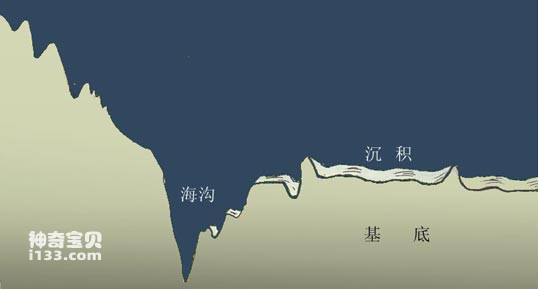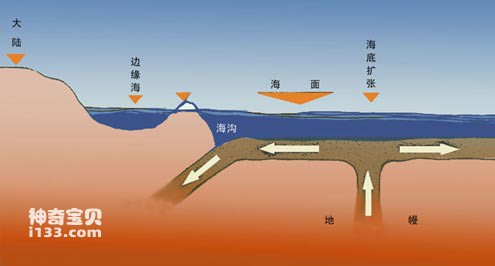Opening the world map, a strange phenomenon immediately comes into view. On the west side of the Pacific Ocean, there are a series of islands arranged in an arc from north to south. They are the Aleutian Islands, Kuril Islands, Japanese Islands, Taiwan Island, Philippine Islands, Ogasawara Islands, Mariana Islands, etc. People give them a nickname called "island arc". Island arcs are like strings of pearls, neatly dotted between the Pacific Ocean and its marginal seas; like teams of sentinels, guarding and vigilant around the Asian continent day and night.
No coincidence. Echoing this interesting arrangement of island arcs, almost all ocean trenches are associated with them on the ocean side of the island arcs. Such as the Aleutian Trench, Kuril Trench, Japan Trench, Ryukyu Trench, Philippine Trench, Mariana Trench, etc., almost one-to-one correspondence, also forming a series of arc-shaped trenches. Island arcs and trenches are like twin sisters, inseparable and inseparable; one island and one trench appear unique and valuable. Other oceans also have the phenomenon of islands and trenches, such as the Puerto Rico Islands and the Puerto Rico Trench in the Atlantic Ocean. The geological structures are similar, but they are not as concentrated as in the western Pacific, nor are they so prominent and typical. Such an interesting arrangement is not the will of God, but a manifestation of the inherent power of nature, the result of the interaction between the ocean floor and adjacent land.

Schematic diagram of ocean trench section

Trench formed by seafloor spreading
A trench is the deepest place in the ocean. It is not in the center of the ocean, but on the edge of the ocean. There are about 30 trenches in the world's oceans, of which 17 are the main ones. There are 14 in the Pacific Ocean, and most of them are concentrated on the west side. There are only three trenches in the east: the Central American Trench, the Peruvian Trench, and the Chilean Trench. There are two in the Atlantic Ocean (Puerto Rico Trench and South Sandwich Trench). There is one trench in the Indian Ocean called the Java Trench.
The depth of ocean trenches is generally greater than 6,000 meters. The deepest trench in the world is on the west side of the Pacific Ocean, called the Mariana Trench. Its deepest point, Challenger Deep, has a maximum depth of 11,034 meters and is located at north latitude ll. 2l', 142.12' east longitude. If Mount Everest, the roof of the world, were moved here, it would be submerged under 2,000 meters of water. Trench lengths vary from 500 to 4,500 kilometers. The longest trench in the world is the Java Trench in the Indian Ocean, which is 4,500 kilometers long. Some people call the Peru Trench and Chile Trench collectively the Peru-Chile Trench, which is more than 5,900 kilometers long. According to the investigation, although the two trenches are close to each other and almost connected end to end, they are disconnected in the middle and have not been connected yet. The width of the trench is between 40 kilometers and 120 kilometers. The widest trench in the world is the Kurile Trench in the northwest Pacific. Its average width is about 120 kilometers. The widest point greatly exceeds this number. The distance is equivalent to the distance from Beijing to Tianjin. Listen It's wide enough, but among the structures on the ocean floor, it's the narrowest terrain.

Schematic diagram of island arcs and trenches on the western side of the Pacific Ocean
After years of investigation, scientists have learned that the trench is the deepest place in the ocean. Its cross-sectional shape is like an English letter "V", but the two sides are asymmetrical. The side facing the ocean is relatively gentle, and the side facing the continent is relatively gentle. The side is steeper. On the side near the ocean is the basalt oceanic crust. The geomagnetic field here is distributed in positive and negative directions, clearly recording the changes in the geomagnetic field in geological history. On the side near the continent is the continental crust, with basalt covered by thick granite. , there is no abnormal performance of geomagnetic field strips. This shows that the bottom of the trench is the junction of the continental and oceanic crusts, but they do not live in harmony here, but collide with each other; like two "Hercules pushing up an ox". Because the oceanic crust is dense and low-lying, and is burdened with thick and heavy sea water, it is really difficult to lift the head up, so we have to swoop down and dive under the continental crust. At the same time, it also arches the land hard, causing the continental crust to rise. Curved into an island. This is why trenches are mostly associated with island arcs. When one side of the island arc receives the thrust of the ocean floor, it will continue to rise, and the slope of the ditch on the landward side will inevitably become steeper, which naturally led to its current appearance.
animal tags:
We created this article in conjunction with AI technology, then made sure it was fact-checked and edited by a Animals Top editor.